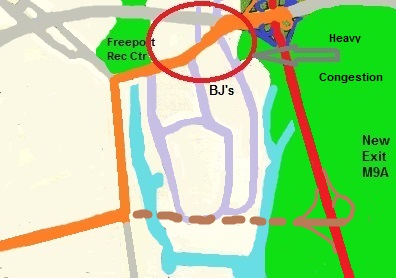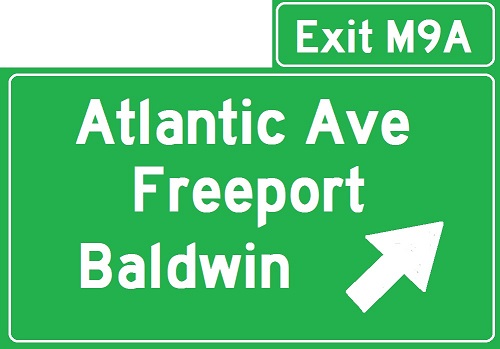Time for a New Exit M9A on the Meadowbrook Parkway
If you've sat in traffic on Mill Road in Freeport, watched any number of dangerous maneuvers in the area, or narrowly escaped an accident, you know that the area is heavily congested beyond its design and capacity. While some steps have been taken at the intersection with Merrick Road over the years, most of those measures amount to nothing more than working around the edges. The problems in the area really have not been addressed in any meaningful way. The heart of the congestion is the red circled area in the diagram to the right.
The basis of the problem is the large number of vehicles that travel between Atlantic Avenue in Freeport and Merrick Road via South Main Street and Mill Road. The route is shown in orange on the diagram. This is because Atlantic Avenue dies an abrupt death at South Main Street, where most eastbound vehicles turn left and most southbound vehicles turn right. Contributing to this volume is a large industrial area south of Mill Road with no other access apart from Mill Road, and adding insult to injury is a BJ's Warehouse south of Mill Road, again, with no other access.
|  |
This layout creates several problems. It requires a two-lane ramp and a traffic signal off the southbound Meadowbrook Parkway at Exit M9W, where the traffic regulations are routinely ignored. Most of the traffic is heading for Mill Road, which requires two left turn lanes on Merrick Road. One of those lanes is routinely blocked by traffic making a left onto Albany Avenue southbound, a left that normally would be prohibited except for the paucity of other means of ingress to the industrial area. The left onto Albany Avenue is very difficult because of the heavy traffic coming from Mill Road eastbound onto Merrick Road. Whenever a vehicle needs to make the left onto Albany Avenue, the capacity of the left turn lanes is essentially halved. Vehicles often try to make the left onto Mill Road from the leftmost through traffic lane on Merrick Road, which apart from being dangerous and illegal, reduces the through traffic capacity on Merrick Road.
An occasionally attractive alternative is to make the next left onto Buffalo Avenue southbound, but because it is only a short distance to the west, the single turn lane there can't store too many vehicles, and that combined with the wait at the stop sign at Mill Road and Buffalo Avenue can make the alternate not worthwhile. The left turn arrow at Buffalo Avenue and Merrick Road is welcome but without storage capacity in the turn lane it doesn't really help much.
A number of drivers attempt to avoid the congestion at Mill Road and Merrick Road by exiting the southbound parkway earlier, at exit M8W. Then they make a dangerous maneuver by cutting across three lanes of westbound Sunrise Highway traffic to make a left onto Buffalo Avenue southbound, often holding up traffic on the exit ramp while they look for an opening in traffic. Then they only wind up at the stop sign at Mill Road waiting a while for an opening there.
Eastbound, since a large portion of the traffic is heading for the Meadowbrook Parkway, vehicles frequently make late moves into the right lane after they get onto Merrick Road. The signal appears to be set to favor Mill Road, so eastbound traffic on Merrick Road typically gets less time than it ordinarily would and starts to accumulate, sometimes spilling into the Buffalo Avenue intersection, making the aforementioned left turns onto Buffalo Avenue more difficult on account of gridlock. Despite the signal favoring Mill Road, the volume is just too great, and vehicles accumulate there as well, which in turn makes exiting the BJ's parking lot more difficult. Even worse, some green signal time must be taken from both Mill Road and Merrick Road to allow traffic on Albany Avenue to exit the industrial area. Again, the usual solution for this is to make Albany Avenue one-way southbound (or even block it off altogether) to simplify the intersection, but since the industrial area has only two other exits (at Hanse Avenue and Buffalo Avenue) this really wouldn't help; traffic would simply get more congested at the other two traffic signals on Mill Road. The Albany Avenue dead-end north of Merrick Road doesn't help either and couldn't be closed off without blocking access to property on that street. It's an intersection where everyone is basically left underserved and disappointed.
The solution here is not easy, nor is it inexpensive, but that makes it no less necessary. What is required here is to extend Atlantic Avenue to a new trumpet interchange M9A with the Meadowbrook Parkway, as shown on the diagram with a brown dotted line. This will require land acquisition and, yes, demolition and relocation of whatever is in the path of the new roadway. Keep in mind that almost the entire Seaford-Oyster Bay Expressway was constructed by bulldozing homes. The Southern State Parkway was orignally a four-land undivided highway; its expansion to a divided six-lane highway was accomplished mostly by bulldozing homes. As rotten a highway as the Cross-Bronx Expressway is, again, it was constructed by bulldozing apartment houses. Where would all that traffic be going today if the expressway weren't there? Conversely, some of the most potentially useful unconstructed links in our regional highway system could be built on land already owned by the state or on land that would require little or no demolition-- but these projects aren't built either. The idea that land acquisition and demolition is absolutely wrong or is a last resort needs to be reconsidered.
The missing link of Atlantic Avenue could be built entirely elevated on a viaduct over the peninsula that it would cross, or it could descend to ground level between the two waterways. The latter would have the advantage of creating additional ingress and egress to the industrial area to the north, including BJ's. Another alternative might be a diamond interchange on Atlantic Avenue with Hanse Avene and Buffalo Avenue remaining below Atlantic Avenue. This latter alternative has the advantage of keeping traffic flowing on the Atlantic Avenue extension.
Immediately, Mill Road would become far more bearable and its intersection with Merrick Road would become far less important as southbound traffic headed for Atlantic Avenue would bypass Mill Road and head directly for Atlantic Avenue via exit M9A. Merrick Road westbound could be channelized to prevent left turns by traffic that just exited the parkway, which would make things much safer. Similarly, the intersection at Sunrise Highway and Buffalo Avenue could be channelized to prevent drivers from exiting the parkway and turning left at Buffalo Avenue, increasing safety significantly. Eastbound traffic heading for the parkway would bypass Mill Road and go directly to the parkway. Even eastbound traffic heading for Merrick Road could utilize the bypass and exit at Merrick Road eastbound toward Bellmore, possibly on a continuous fourth lane between the entrance ramp at M9A and the exit ramp at M9E. If enough westbound traffic wanted to use the bypass, a reconstruction of the Merrick Road overpass over the parkway would be worthwhile to add through merge lanes underneath it and raise its height, making it less susceptible to truck and bus strikes as a side benefit. That could be a separate project or a project combined with the required new interchange.




